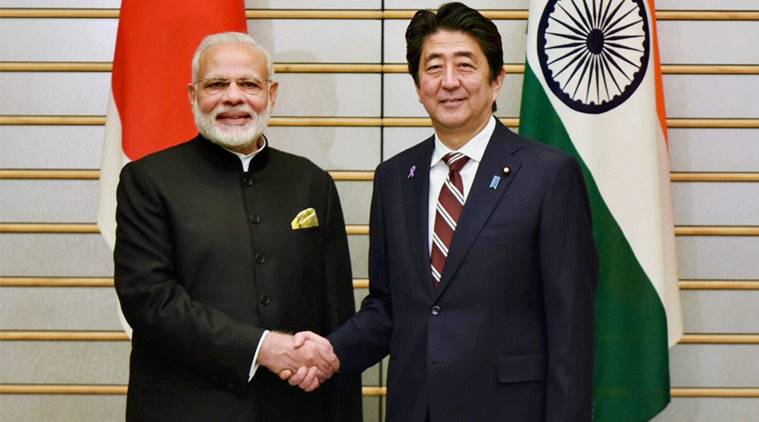East meets east
India-Japan ties are warming up but expectations from Modi-Abe discussions must remain anchored in reality

The warm Modi-Abe relationship has been built over 12 meetings, including four summits, since 2014. (PTI Photo/File)
According to author Pankaj Mishra, the roots of the putative “rise of the East” can be traced to May 1905, when a Japanese fleet, commanded by Admiral Togo, decimated much of Imperial Russia’s navy at the Battle of Tsushima Strait. Europe’s humiliation by an Asian Power — inconceivable till then — galvanised patriotic sentiment all over the eastern world, including India, and set the stage for its retreat from the east.
It may be a leap of faith to link Prime Minister Narendra Modi’s close personal bonding with Japanese PM, Shinzo Abe, to this century-old event, but India’s high regard for Japan is certainly rooted in shared history. The warm Modi-Abe relationship has been built over 12 meetings, including four summits, since 2014. Such symbiosis, unusual in international relations, has, understandably, heightened interest in the 13th India-Japan Summit, scheduled on October 28-29 in Tokyo.
There are other reasons too, for observers to anticipate that the Indo-Japanese relationship will, at last, deliver tangible results. Primary amongst them is China’s economic and military rise, its growing belligerence and its refusal to comply with the existing rule-based order.
The alarm bells rung by China’s capricious actions in the East and South China Seas, and its relentless quest for distant Indian Ocean footholds, have focused sharp attention on maritime-security in the region. The Belt and Road Initiative (BRI), hawked to the world as a benign bid to enhance regional connectivity, is, actually, a project of geo-strategic significance that will ensure China’s long-term economic security while reshaping the global geo-economic order.
Along with enhanced maritime-security consciousness has come a realisation of the seamless nature of the oceanic domain; resulting in the coinage of new terms and concepts. The “Asia-Pacific” entity, created, post-WW II, by the US State Department, having outlived its utility, has been stretched westwards, almost certainly, to include India, and create the new “Indo-Pacific” paradigm.
Japan, as a resource-deficient island state and major economy, is totally dependent on sea-lanes for its energy, commerce, industry and security. Despite crucial reliance on the seas, Japan faces serious capacity limitations in its ability to protect its sea-borne trade and energy traffic. Apart from the tyranny of distance (a ship could take up to 18 days to cover the 12,000 km from Japan to the Persian Gulf), it is also constrained by constitutional curbs on the maintenance of military/naval forces and their deployment overseas.
India, as a significant naval power with a dominant peninsular location astride shipping-lanes, plays a major role in ensuring maritime security in the Indian Ocean and its environs. Close cooperation with a democratic India, located mid-way along trade-routes connecting East Asia with the Middle East and Africa, would be advantageous to Japan. At the same time, a technologically deficient India has much to gain from a relationship with a country like Japan.
Japan and India have, no doubt, been drawing closer, since 2001, after the lifting of Japan’s post-Pokharan II sanctions. Regular prime-ministerial exchanges have yielded a “special strategic partnership” as well as a landmark civil nuclear agreement. A Defence Cooperation Agreement was signed in 2006 and Japan was, formally, admitted as the third member of the “Malabar” Indo-US naval exercises last year.
There is, however, a sense of dissatisfaction in New Delhi that the Indo-Japanese relationship has remained below potential, and that Japan does not accord due importance to India in its security calculus. This discontent arises mainly from the fact that the decade-long security dialogue has failed to throw up any deliverables so far. There is also frustration that Japan has offered neither military hardware, nor technology to India. Finally, there seems to be a difference in perceptions about China; Japan, while highlighting its own security concerns in the East and South China Seas, is seen to play down the multiple threats that India faces from China.
It is, therefore, important that expectations from the forthcoming Modi-Abe discussions remain anchored in reality. In this context, two major factors have a strong bearing on the India-Japan security relationship and must be taken note of.
The US-imposed, Japanese post-WW II Constitution denies not just the right of belligerency to the state, but also the authority to raise national armed forces. Japan, therefore maintains three wings of a putative “Japanese Self Defence Force” (JSDF). With a budget of US $ 50 billion, the compact JSDF is formidable in capability, but fettered in its ability to undertake combat operations or overseas deployments.
Notionally, there are also legal constraints on the transfer of arms and technology to other nations. However, in 2015 the Japanese government approved “reinterpretations” of the Constitution to permit the JSDF to provide material and logistic support to allies, internationally. PM Abe’s ruling Liberal Democratic Party has, in any case, been committed to constitutional revision since its founding.
Equal in significance are the conditions imposed on Japan by the 1951 US-Japan Security Treaty, which grants the US the means to establish a large military presence in East Asia, and binds the two militaries to intense operational cooperation. The bar imposed by this treaty on military-related assistance to other powers without US consent will always have the Japanese looking over their shoulders.
As the two prime ministers seek a modus vivendi for navigating hurdles and realising the potential of the Indo-Japanese relationship, especially in the fields of defence and security, they should be buoyed by the fact that India and Japan, of all Asian nations, carry no historical burden of the past.
Paradoxically, while the Japanese are keen to forget their imperial past, sentimental Indians keenly recall three historical landmarks in India-Japan relations; the accord of recognition to Subhas Bose’s Provisional Government of Free India by the Diet, in 1943; Justice Radhabinod Pal’s vociferous dissent in the Tokyo war crimes trials of 1946; and the signing of a separate Indo-Japanese Peace Treaty, according honour and equality to Japan, in 1951. One hopes that these will serve to inspire our future relationship.
The writer is a former Chief of the Indian Navy.
For all the latest Opinion News, download Indian Express App
More From Arun Prakash
- Who defends the defenders?Serving soldiers have approached SC over AFSPA. They must not be made to pay for governments’ failures. ..
- Abandoned at seaChina’s maritime strategy calls for a paradigm shift in India’s defence-industrial programmes. But declining budgets, dysfunctional acquisitions could stymie strategic necessities...
- Reappraising India-USDefence cooperation remains high on rhetoric, short on delivery. Both South Block and Capitol Hill need to do more to revitalise and elevate ties...







































No hay comentarios:
Publicar un comentario